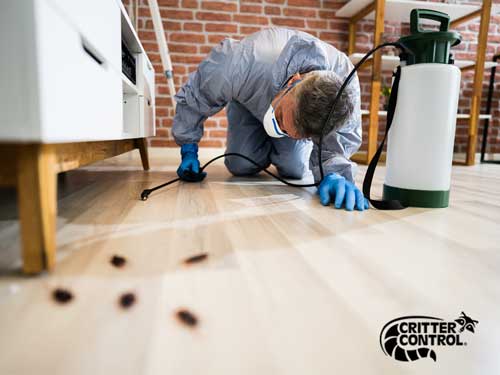Effective A1 Bed Bug Treatment in Charlotte - Safe and Proven Approaches
Effective A1 Bed Bug Treatment in Charlotte - Safe and Proven Approaches
Blog Article
Bed Pest Treatment Breakdown: Comparing Chemical Vs. Non-Chemical Solutions
In the world of pest control, specifically when taking care of the persistent problem of bed pests, the choice in between chemical and non-chemical treatment services can be a crucial one. Both methods use distinct advantages and downsides, affecting elements such as performance, safety considerations, and general price. By taking a look at the nuanced details of each method, a more clear understanding of which course to go after in dealing with a bed pest problem can be obtained.
Effectiveness of Chemical Therapies
Chemical therapies for bed bug invasions have actually been extensively recognized for their quick and powerful efficiency in eliminating these insects. When considering the efficiency of chemical treatments, it is essential to comprehend that they can supply a fast and thorough service to a bed insect issue. Expert pest control experts frequently depend on insecticides to target bed bugs at various stages of their life process, consisting of eggs, fairies, and grownups. These chemicals typically function by interfering with the bed insects' nerves, bring about paralysis and eventual fatality.
Additionally, chemical therapies have the benefit of providing recurring impacts, implying that they can proceed to get rid of bed bugs also after the initial application. This recurring activity is especially helpful in combating any type of potential re-infestations. Furthermore, the rapid activity of chemical treatments can bring relief to people facing extreme bed insect problems, enabling them to regain control of their living rooms rapidly.
Safety Worries With Chemical Solutions
One important facet that requires cautious consideration when making use of chemical options for bed pest treatment is making certain the safety of occupants and the setting. Direct exposure to specific chemicals used in bed pest treatments can lead to respiratory system problems, skin irritation, or various other unfavorable responses, specifically in people with pre-existing conditions or level of sensitivities.
Furthermore, the ecological effect of chemical solutions is one more substantial consideration. Some chemicals made use of in bed bug therapies might be unsafe to useful insects, wild animals, and communities if they seep into the dirt or water supply. It is necessary to make use of chemical treatments carefully, following safety and security guidelines, and taking into consideration less toxic choices to reduce these dangers and guarantee the reliable and safe administration of bed insect problems.
Benefits of Non-Chemical Techniques
Taking into consideration the prospective security issues and environmental influence linked with chemical services for bed bug treatment, checking out non-chemical approaches presents an encouraging alternative with several distinctive advantages. Non-chemical treatments are environmentally pleasant, as they do not contribute to air or water pollution, making them a lasting option for insect control.
Additionally, non-chemical remedies can be efficient in targeting bed bugs, including hard-to-reach locations where chemical treatments might not penetrate. Methods such as warmth treatment, vacuuming, vapor cleaning, and cushion coverings supply detailed obliteration without making use of harmful chemicals. Additionally, non-chemical strategies can be less turbulent, requiring minimal prep work and enabling quicker reentry into dealt with areas. Overall, selecting non-chemical bed bug therapy approaches not only focuses on safety and environmental management however additionally makes certain extensive and effective insect control.
Limitations of Non-Chemical Treatments

In addition, non-chemical treatments usually require numerous applications to accomplish effective removal. This can be taxing and might not constantly assure total elimination of all bed insects and their eggs, particularly in hard-to-reach or concealed places.
In addition, the success of non-chemical treatments heavily counts on appropriate execution and thoroughness, which see post can be challenging for individuals without expert knowledge. Poor application of non-chemical methods may lead pest inspection services to insufficient obliteration, causing relentless problems and the need for additional treatments.
As a result, while non-chemical therapies have their benefits, it is necessary to acknowledge these restrictions and consider them when establishing the most efficient technique for handling bed insect invasions.
Cost Comparison: Chemical Vs. Non-Chemical Options
Given the limitations associated with non-chemical treatments, a vital facet to evaluate in the context of bed pest monitoring is the price comparison between chemical and non-chemical choices. Chemical treatments usually include the application of insecticides by experts, which can range from $250 to $900 per room, depending on the severity of the problem and the dimension of the location to be treated. On the other hand, non-chemical treatments like warmth therapy or vapor can be a lot more costly, with costs varying from $1,000 to $6,000 for an entire home. While the initial price of chemical treatments might appear lower, several treatments might be called for to totally remove the problem, possibly enhancing the general price. On the other hand, non-chemical alternatives may supply a more eco-friendly and lasting remedy, although they can be cost-prohibitive for some individuals. Eventually, when taking into consideration the expense of bed pest therapy options, it is essential to weigh the ahead of time costs versus the efficiency and lasting sustainability of the selected method.
Final Thought

Taking into consideration the prospective safety and security issues and ecological influence associated with chemical remedies for bed insect treatment, discovering non-chemical methods provides an encouraging option with a number of distinctive benefits.Given the restrictions associated with non-chemical therapies, an important element to review in the context of bed bug administration is the cost contrast in between chemical and non-chemical alternatives. In contrast, non-chemical treatments like heat therapy or steam can be much more costly, with expenses ranging from $1,000 to $6,000 for a whole home. While the initial expense of chemical therapies might appear reduced, multiple treatments may be needed to completely get rid of the problem, potentially raising the overall expense.In final thought, when contrasting chemical and non-chemical bed insect therapy choices, it is essential to consider effectiveness, safety, advantages, constraints, and price.
Report this page